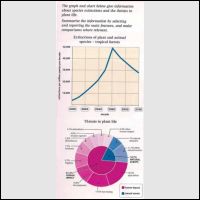A breakdown of the figure for extinction of plant and animal species, and the treats to plant life is shown in line and pie chart respectively. This is important to note that an extreme upward is shown in the line chart. In any case, another chart illustrate human has a tremendous impact in plant live.
The percentage of human impact has 7 times as much as natural events. The most noticeable percentage in human impact comes to Agriculture, while development's level roughly a half as much. The level of the highest one is followed by the percentage of harvesting. A small proportion is seen in other proportion which is no more out of ten. In anycase, when it comes to natural proportion, Natural disaster's level shows approximately the same as other natural events had been a small proportion as well.
Turning to the level of extinction of plant and animal, overall changes are not always steady. The most noticeable proportion is forecast to increase in the number of these species, when this level will increase from 2000 to 2040. This will reach a peak approximately 50,000 per million people per decade in the following year. Between 2080 and 2100, such number will decline rapidly, a plunge of about 20,000 per million per decades in 40 years.
The percentage of human impact has 7 times as much as natural events. The most noticeable percentage in human impact comes to Agriculture, while development's level roughly a half as much. The level of the highest one is followed by the percentage of harvesting. A small proportion is seen in other proportion which is no more out of ten. In anycase, when it comes to natural proportion, Natural disaster's level shows approximately the same as other natural events had been a small proportion as well.
Turning to the level of extinction of plant and animal, overall changes are not always steady. The most noticeable proportion is forecast to increase in the number of these species, when this level will increase from 2000 to 2040. This will reach a peak approximately 50,000 per million people per decade in the following year. Between 2080 and 2100, such number will decline rapidly, a plunge of about 20,000 per million per decades in 40 years.

267553_1.jpg
